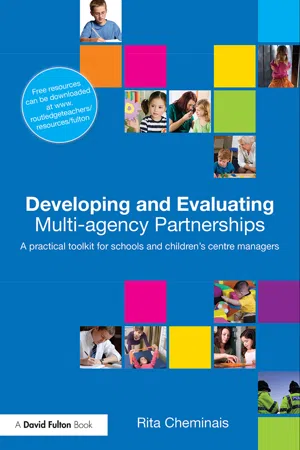
Developing and Evaluating Multi-Agency Partnerships
A Practical Toolkit for Schools and Children's Centre Managers
- 112 pages
- English
- ePUB (mobile friendly)
- Available on iOS & Android
Developing and Evaluating Multi-Agency Partnerships
A Practical Toolkit for Schools and Children's Centre Managers
About This Book
In recent years government initiatives such as Sure Start, Extended Schools and Every Child Matters have been significant in the promotion of an agenda to create collaborative working environments and introduce multi-agency practice into a range of child-centred settings. Developing and Evaluating Multi-Agency Partnerships provides advice and guidance for managers and leaders responsible for overseeing multi-agency working in these settings, providing a self-evaluation framework to help improve the quality and effectiveness of multi-agency relationships.
The valuable tools and templates within this book will:
-
- Explain the importance of self-evaluation
-
- Provide a framework for self-evaluation via a step by step guide
-
- Link multi-agency practice with improving the Every Child Matters outcomes
-
- Suggest best practice for gathering multi-agency evidence
-
- Give guidance on building a portfolio of evidence and achieving external recognition
The self-evaluation framework provided in this book meets the requirements of the Children's Workforce standards and OFSTED requirements for effective partnerships. A highly practical handbook, this book is essential reading for all those who are implementing or improving a multi-agency partnership in their setting.
To improve the effectiveness of this resource, additional resources are downloadable in customisable form from http://www.routledgeteachers.com/resources/fulton
Frequently asked questions
Information
1
The origin and benefits of the multi-agency self-evaluation process
The origin of the multi-agency self-evaluation framework and process
The purpose of the multi- agency self-evaluation framework and process
The purpose of the multi-agency self-evaluation framework and process
The pre-requisites for engaging with the multi-agency self-evaluation process
The benefits of engaging with the multi-agency self-evaluation process
2 Overview of the multi-agency self-evaluation process, auditing and action planning
Table of contents
- Contents
- Illustrations
- Acknowlegements
- Abbrevations
- How to use this resource
- Introduction
- 1 The origin and benefits of the multi-agency self-evaluation process
- 2 Overview of the multi-agency self-evaluation process, auditing and action planning
- 3 Compiling a multi-agency portfolio of evidence
- 4 Monitoring, evaluating and assessing progress in multi-agency working
- 5 Achievements and outcomes of engaging with the multi-agency self-evaluation process
- Appendix
- Glossary
- Useful websites
- References and further reading
- Index